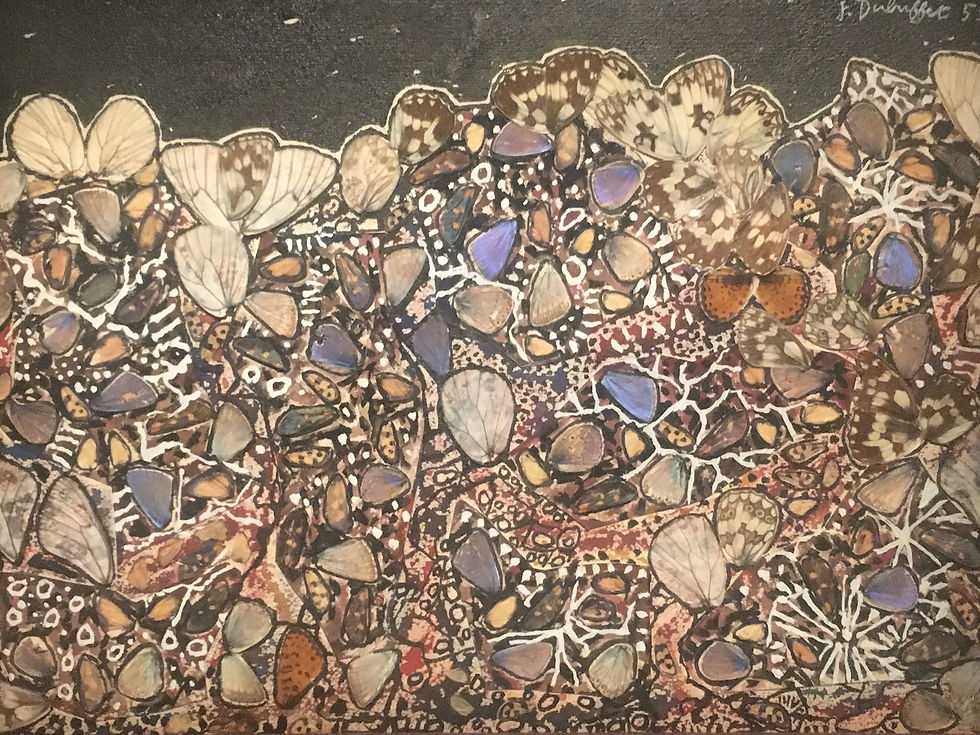Jean Dubuffet: Brutal Beauty
- Lucy Fleming-Brown
- 2021年6月23日
- 読了時間: 3分
Once upon a time, a long time ago, there was a magician called Jean Dubuffet. In his hands, chicken droppings turned into society portraits and visionary artworks proceeded from asylums like so many rabbits pulled out of hats. With impish insouciance and compelling powers to conjure alternative vistas onto a quotidian world, it was not long before all Paris lay beneath his spell.
In this Modernist parable of new beauty and subversive beastliness, Dubuffet is held up as an existentialist hero, rising out of the bleak postwar landscape with an anarchic but ultimately hopeful understanding of art’s dawning horizon. His experimentations with form and aesthetics often outstrip those of avant-garde predecessors, whose revolutions appear merely reactionary in contrast with the new ground broken by Dubuffet during the 1940s and ‘50s. Stripped of Paris’ mid-century magic and divorced from this narrative trajectory, however, this exhibition invites us to reassess Dubuffet’s radicalism in the transfigured context of our own times.

Showing the art brut oracle in a Brutalist arts-labyrinth might seem like too obvious a visual pun, but the Barbican provides a sympathetically neutral environment in which Dubuffet’s work comes into material focus. In previous retrospectives, the tension between gleaming white floors and sparkling glass has reflected both art and gallery in a harsh light. In this exhibition, the course functionalism of the Barbican’s concrete armature gently echoes Dubuffet’s textural fascination; Five paintings from his Texturology series, which use a spattering technique to evoke at once microscopic and universal cosmos, resemble their display surface closely enough to provoke but remain sufficiently mesmeric to illuminate fresh beauty in our artificial environment.

Perhaps this power to transform is the enduring appeal of Dubuffet’s work. His art of the streets is now overshadowed by inheritors who took their work literally beyond the confines of the gallery, like Keith Haring and Jean-Michel Basquiat. Dubuffet’s once unconventional choices of tools and materials pale in contrast today with the shock tactics deployed by the YBAs. The area in which Dubuffet remains an unchallenged master, however, is in his capacity to animate our familiar everyday with alien valences of aesthetic depth.

The techniques are unorthodox, the materials rogue, but the product of these obscure choices is often revelatory. Whether cutting up butterflies into assemblages or lithographically resuscitating old walls, Dubuffet’s eye focuses relentlessly on surfaces, illuminating fragmentary compositions which usually escape our notice, assimilated into the bland texture of modern life. These elements are not imbued with sacred value in his work, but rather celebrated with an enthusiasm for organic variation and tactile uniqueness. This visual argument reaches its distillation in his landscapes from the early 1950s, in which a high horizon refocuses our attentions away from the obvious heavens above, to revel in the earthy, sometimes abject, abstraction of his hautes pâtes.

It’s hard to fault an exhibition that so successfully amplifies Dubuffet’s ingenuity and charm across the decades. The cost of such a focus on his exceptionalism, however, is that it risks understating the role he played in a highly collaborative network of contemporary artists, writers, ethnologists and psychiatrists engaged in overlapping explorations of a new cultural relativism, focalised through the discipline of anthropology. Whilst no exhibition can do everything, it would have been interesting to see Dubuffet’s world through his own lens of interrelated human endeavour, with Dubuffet at the heart of a community rather than banished to more austere glory as the Art Brut savant.




自己理解の旅は、時に複雑で多岐にわたる側面を持つものですね。特に、自身のアイデンティティや感情の深層を探ることは、勇気と内省を要するプロセスだと感じます。社会的な期待と個人の真実の間で揺れ動くことも少なくありません。そうした中で、自分のセクシュアリティについて深く考えることは、自己受容への重要な一歩となり得ますが、その過程でどのように向き合えば良いか、戸惑う方もいるかもしれません。もし、ご自身のセクシュアリティの自己理解を助けるリソースをお探しでしたら、役立つ情報が見つかるかもしれません。